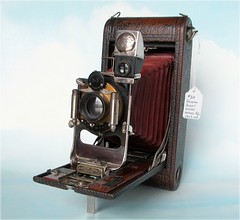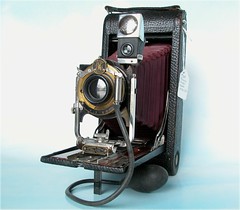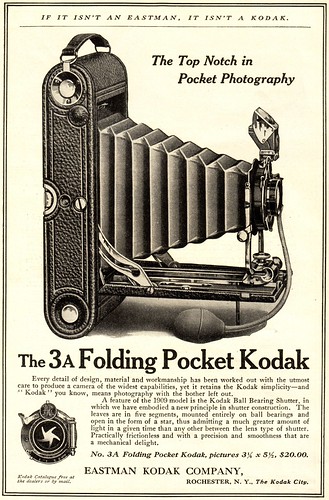Difference between revisions of "No. 3A Folding Pocket Kodak"
Hanskerensky (talk | contribs) m (→Links: Refined Link URL) |
m (Minor text correction) |
||
| Line 16: | Line 16: | ||
|} | |} | ||
----------------------- | ----------------------- | ||
| − | The '''No. 3A Folding Pocket Kodak''' | + | The '''No. 3A Folding Pocket Kodak''' is a [[folding bed camera]] for making exposures in 3¼×5½ inch postcard format on type No. 122 [[rollfilm]]. It was introduced by [[Kodak]] in 1903 and made until 1915. Variants were B, B2, B3, B4, B5, C and G. Early variants were expensive and had for example a combination of Kodak Automatic [[shutter]] and [[Rapid Rectilinear]] lens of [[Bausch & Lomb]]. Later moderately priced variants got the [[Ball Bearing Shutter]]. Both shutters were still for pneumatic remote operation or release by lever. A glass plate adapter was available for the camera. A later expensive variant has a [[Compound]] shutter with [[Zeiss]] Kodak [[Anastigmat]]. |
The production of cameras for that format was continued until 1943 (No. 3A Kodak Series III). | The production of cameras for that format was continued until 1943 (No. 3A Kodak Series III). | ||
Revision as of 05:49, 10 May 2019

|

|

|
| Model B2, 1903, B&L Rapid Rectilinear lens in a B&L Automat shutter |
Model B4, 1909, B&L Rapid Rectilinear lens in a Kodak Ball Bearing shutter |
Model C, 1909, B&L Rapid Rectilinear f/8 (US f4) lens in a Kodak Ball Bearing Shutter on moveable lens board |
|
images by Bill Strong (Image rights) | ||
The No. 3A Folding Pocket Kodak is a folding bed camera for making exposures in 3¼×5½ inch postcard format on type No. 122 rollfilm. It was introduced by Kodak in 1903 and made until 1915. Variants were B, B2, B3, B4, B5, C and G. Early variants were expensive and had for example a combination of Kodak Automatic shutter and Rapid Rectilinear lens of Bausch & Lomb. Later moderately priced variants got the Ball Bearing Shutter. Both shutters were still for pneumatic remote operation or release by lever. A glass plate adapter was available for the camera. A later expensive variant has a Compound shutter with Zeiss Kodak Anastigmat.
The production of cameras for that format was continued until 1943 (No. 3A Kodak Series III).
Links
- early No. 3A Folding Pocket Kodak Camera at Scott's Photographica Collection
- postcard format at Scott's Photographica Collection
- Kodak 3A Camera Manual : Photo-Manuals.com

|
| scanned by Uwe Kulick (Image rights) |